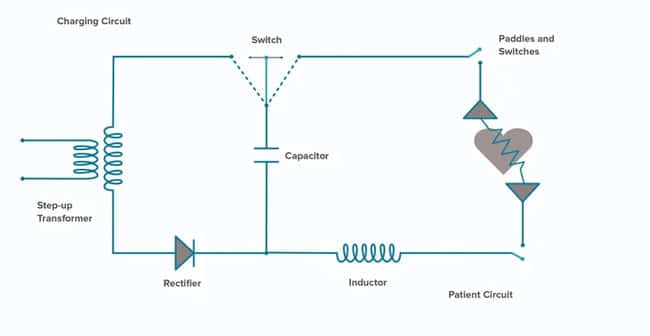This article based on Knowles Precision Devices blog explains role of capacitors in external defibrillators.
Defibrillators are designed to deliver electric current to the heart, in the form of a controlled shock to the myocardium, to treat arrhythmias and restore the heartbeat back to normal.
Capacitors play an important role in the function of these life-saving devices. Here, we’ll cover the basic components of a defibrillator circuit and explore the role of capacitor selection in defibrillator system design.
In its simplest form, a defibrillator circuit includes a capacitor, transformer, rectifier and inductor (Figure 1). The transformer serves the charging process by increasing the voltage from hundreds to thousands of volts to deliver the desired energy output.
Voltage is converted to direct current (DC) via the rectifier, which allows current to flow unidirectionally to charge the capacitor. Once charged, paddles are applied to a patient’s chest to complete the circuit. The inductor is responsible for maintaining current flow for several milliseconds to properly treat the patient.
Defibrillation leverages monophasic or biphasic waveforms to ensure effective treatment with minimal myocardial damage (Figure 2). Biphasic waveforms are more common in modern systems. With this approach, defibrillation delivers a shock in two directions, rather than one, by reversing polarity mid-cycle. Truncated exponential biphasic waveforms discharge the capacitor through the patient with a normal exponential decay that’s reversed using switches on a timing circuit.
The instantaneous power required for defibrillation isn’t supported by a typical mains electricity supply, so you need an adjustable or step-up transformer to convert mains voltage alternating current (AC) to high-voltage AC. From there, it’s converted to high-voltage DC via the rectifier. Variable voltage step-up transformers allow physicians to select the adequate charge to suit the patient.
The Role of Capacitors in External Defibrillators
Capacitors are responsible for storing a large amount of electrical charge and releasing it quickly into the patient, and effective treatment depends on that charge/discharge process. Capacitor specifications impact pulse size and shape as well as overall system form factor and reliability.
Knowles’ Cornell Dubilier brand high-reliability film capacitors for external defibrillators are designed using extensive process validation and rigorous quality testing to ensure a long product lifetime and complete traceability. With a small form factor, the defibrillator film capacitors are ideally suited for portable defibrillation equipment.
Source: Knowles Precision Devices
